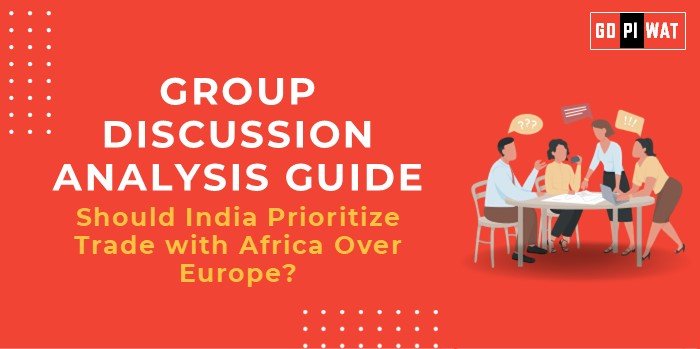📋 Group Discussion Analysis Guide: Should India Prioritize Trade with Africa Over Europe?
🌐 Introduction
India is at a crossroads in its trade priorities, balancing the stability and technological benefits of trade with Europe against the resource-rich, high-growth opportunities offered by Africa. While Europe remains India’s largest trading partner, Africa presents immense potential for economic collaboration and diversification.
📊 Quick Facts & Key Statistics
- 📈 India’s Trade with Europe: €124 billion in 2023, accounting for 12.2% of India’s total trade.
- 🌍 India’s Trade with Africa: $100 billion in FY 2022-2023, with exports at $51.2 billion and imports at $46.65 billion.
- 📉 Africa’s GDP Growth Rate: Projected at 4% in 2023-2024, signaling a robust economic trajectory.
- 💰 India’s Investments in Africa: $70 billion cumulatively, making India Africa’s third-largest trading partner after the EU and China.
🧩 Stakeholders and Their Roles
- 🏛️ Government of India: Policies on trade diversification and regional partnerships.
- 🤝 African Nations: Collaborating for infrastructure development and resource trade.
- 🇪🇺 European Union: A strong and stable trade partner offering high-value imports and exports.
- 🏢 Private Sector: Indian companies in energy, pharmaceuticals, and IT targeting African markets for growth and Europe for technology collaborations.
🏆 Achievements and Challenges
- 🌍 Achievements:
- India’s significant investments in Africa’s renewable energy and infrastructure have bolstered its influence.
- Continued strong trade relations with Europe, accounting for 12.2% of India’s total trade in 2023.
- ⚠️ Challenges:
- Africa: Infrastructure limitations, political instability, and logistical barriers.
- Europe: Increasing regulatory barriers and competition from other global players.
🌐 Global Comparisons
- 📊 China-Africa: $250 billion trade highlights the scale of opportunity India can aim for.
- 🇪🇺 EU-India: Negotiations on Free Trade Agreements reflect opportunities for deeper trade ties.
📖 Case Studies
- 📍 Africa: Rwanda’s infrastructure modernization supported by Indian investments.
- ⚙️ Europe: Strategic trade in pharmaceuticals and machinery highlights mutual benefits.
💡 Effective Discussion Approaches
- 📈 Opening Techniques:
- Data-driven: “In 2023, India traded €124 billion with the EU while reaching $100 billion with Africa, reflecting two contrasting but critical trade dynamics…”
- Contextual: “Africa’s projected 4% GDP growth and untapped markets pose a compelling trade argument for India.”
- 🎯 Counter-Argument Handling:
- Africa: Address concerns on infrastructure by citing Indian-funded projects.
- Europe: Emphasize its stability as a tech partner while advocating diversification.
🔍 Strategic Analysis of Strengths & Weaknesses
- 📈 Strengths: High growth potential in Africa and long-established technological partnerships in Europe.
- ⚠️ Weaknesses: Infrastructure gaps in Africa and regulatory challenges in Europe.
- 🌟 Opportunities: Africa’s renewable energy projects and collaborative R&D in Europe.
- ⚡ Threats: Rising competition from China in Africa and geopolitical instability affecting trade dynamics.
🖋️ Structured Arguments for Discussion
- ✅ Supporting Stance: “Prioritizing Africa allows India to tap into high-growth markets and strengthen resource security.”
- ❌ Opposing Stance: “Europe’s stability and technological advantage make it indispensable for India’s growth trajectory.”
- ⚖️ Balanced Perspective: “India should expand its trade with Africa without undermining its critical partnerships with Europe.”
📄 Connecting with B-School Applications
- 🌍 Real-World Applications: Case studies in international trade policy and supply chain optimization.
- 💡 Sample Questions:
- “How should India balance its trade policies between developed and developing regions?”
- “What can India learn from China’s trade strategy with Africa?”
- ✨ Insights: Africa offers unique project opportunities in renewable energy and sustainable trade.


